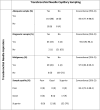Randomized clinical trial of endobronchial ultrasound needle biopsy with and without aspiration
- PMID: 22156610
- PMCID: PMC3610596
- DOI: 10.1378/chest.11-0692
Randomized clinical trial of endobronchial ultrasound needle biopsy with and without aspiration
Abstract
Background: Endobronchial ultrasound (EBUS)-guided transbronchial needle aspiration (EBUS-TBNA) is performed with a dedicated 22- or 21-gauge needle while suction is applied. Fine-needle sampling without suction (capillary sampling) has been studied for endoscopic ultrasound and for biopsies at various body sites and has resulted in similar diagnostic yield and fewer traumatic samples. However, the role of EBUS-guided transbronchial needle capillary sampling (EBUS-TBNCS) is still to be determined.
Methods: Adults with suspicious hilar or mediastinal lymph nodes (LNs) were included in a single-blinded, prospective, randomized trial comparing EBUS-TBNA and EBUS-TBNCS. The primary end point was the concordance rate between the two techniques in terms of adequacy and diagnosis of cytologic samples. The secondary end point was the concordance rate between the two techniques in terms of quality of samples.
Results: A total of 115 patients and 192 LNs were studied. Concordance between EBUS-TBNA and EBUS-TBNCS was high, with no significant difference in adequacy (88% vs 88%, respectively [P ± .858]; concordance rate, 83.9% [95% CI, 77.9-88.8]); diagnosis (36% vs 34%, respectively [P ± .289]; concordance rate, 95.8% [95% CI, 92-92.8]); diagnosis of malignancy (28% vs 26%, respectively [P ± .125]; concordance rate, 97.9% [95% CI, 94.8-99.4]); or sample quality (concordance rate, 83.3% [95% CI, 73.3-88.3]). Concordance between EBUS-TBNA and EBUS-TBNCS was high irrespective of LN size (≤ 1 cm vs > 1 cm).
Conclusions: Regardless of LN size, no differences in adequacy, diagnosis, or quality were found between samples obtained using EBUS-TBNA and those obtained using EBUS-TBNCS. There is no evidence of any benefit derived from the practice of applying suction to EBUS-guided biopsies.
Trial registry: ClinicalTrials.gov; No.: NCT00886847; URL: www.clinicaltrials.gov
Figures
Comment in
-
The value of answering simple bronchoscopy questions with randomized clinical trials.Chest. 2012 Sep;142(3):551-552. doi: 10.1378/chest.12-0508. Chest. 2012. PMID: 22948570 No abstract available.
-
Endobronchial ultrasound needle biopsy with and without aspiration: the "core" issue.Chest. 2013 Jan;143(1):281-282. doi: 10.1378/chest.12-2239. Chest. 2013. PMID: 23276871 No abstract available.
-
Response.Chest. 2013 Jan;143(1):282-283. doi: 10.1378/chest.12-2477. Chest. 2013. PMID: 23276873 Free PMC article. No abstract available.
-
Randomized trials and bronchoscopy.Chest. 2013 Feb 1;143(2):584. doi: 10.1378/chest.12-2423. Chest. 2013. PMID: 23381339 No abstract available.
-
Response.Chest. 2013 Feb 1;143(2):584-585. doi: 10.1378/chest.12-2631. Chest. 2013. PMID: 23381340 Free PMC article. No abstract available.
Similar articles
-
Comparison of 21-gauge and 22-gauge aspiration needle in endobronchial ultrasound-guided transbronchial needle aspiration: results of the American College of Chest Physicians Quality Improvement Registry, Education, and Evaluation Registry.Chest. 2013 Apr;143(4):1036-1043. doi: 10.1378/chest.12-1205. Chest. 2013. PMID: 23632441 Free PMC article.
-
Randomized Cross-over Trial of Endobronchial Ultrasound Transbronchial Needle Aspiration With or Without Suction in Suspected Malignant Lymphadenopathy.J Bronchology Interv Pulmonol. 2022 Apr 1;29(2):131-139. doi: 10.1097/LBR.0000000000000801. J Bronchology Interv Pulmonol. 2022. PMID: 34369402 Clinical Trial.
-
A randomized controlled trial of standard vs endobronchial ultrasonography-guided transbronchial needle aspiration in patients with suspected sarcoidosis.Chest. 2009 Aug;136(2):340-346. doi: 10.1378/chest.08-2768. Epub 2009 Feb 2. Chest. 2009. PMID: 19188547 Clinical Trial.
-
Cytological specimens obtained by endobronchial ultrasound-guided transbronchial needle aspiration: sample handling and role of rapid on-site evaluation.Ann Pathol. 2012 Dec;32(6):e35-46, 421-32. doi: 10.1016/j.annpat.2012.09.212. Epub 2012 Nov 20. Ann Pathol. 2012. PMID: 23244484 Review. English, French.
-
Impact of Rapid On-Site Cytological Evaluation (ROSE) on the Diagnostic Yield of Transbronchial Needle Aspiration During Mediastinal Lymph Node Sampling: Systematic Review and Meta-Analysis.Chest. 2018 Apr;153(4):929-938. doi: 10.1016/j.chest.2017.11.004. Epub 2017 Nov 15. Chest. 2018. PMID: 29154972
Cited by
-
High SUVmax Is an Independent Predictor of Higher Diagnostic Accuracy of ROSE in EBUS-TBNA for Patients with NSCLC.J Pers Med. 2022 Mar 13;12(3):451. doi: 10.3390/jpm12030451. J Pers Med. 2022. PMID: 35330451 Free PMC article.
-
Linear Endobronchial Ultrasound in the Era of Personalized Lung Cancer Diagnostics-A Technical Review.J Clin Med. 2021 Nov 30;10(23):5646. doi: 10.3390/jcm10235646. J Clin Med. 2021. PMID: 34884348 Free PMC article. Review.
-
Comparison of cytologic accuracy of endobronchial ultrasound transbronchial needle aspiration using needle suction versus no suction.Endosc Ultrasound. 2015 Apr-Jun;4(2):115-9. doi: 10.4103/2303-9027.156737. Endosc Ultrasound. 2015. PMID: 26020045 Free PMC article.
-
Diagnostic bronchoscopy--current and future perspectives.J Thorac Dis. 2013 Oct;5 Suppl 5(Suppl 5):S498-510. doi: 10.3978/j.issn.2072-1439.2013.09.08. J Thorac Dis. 2013. PMID: 24163743 Free PMC article. Review.
-
Endoscopic ultrasonography guided-fine needle aspiration for the diagnosis of solid pancreaticobiliary lesions: Clinical aspects to improve the diagnosis.World J Gastroenterol. 2016 Jan 14;22(2):628-40. doi: 10.3748/wjg.v22.i2.628. World J Gastroenterol. 2016. PMID: 26811612 Free PMC article. Review.
References
-
- Yasufuku K, Chiyo M, Sekine Y, et al. Real-time endobronchial ultrasound-guided transbronchial needle aspiration of mediastinal and hilar lymph nodes. Chest. 2004;126(1):122-128 - PubMed
-
- Ernst A, Anantham D, Eberhardt R, Krasnik M, Herth FJ. Diagnosis of mediastinal adenopathy-real-time endobronchial ultrasound guided needle aspiration versus mediastinoscopy. J Thorac Oncol. 2008;3(6):577-582 - PubMed
-
- Ghosh A, Misra RK, Sharma SP, Singh HN, Chaturvedi AK. Aspiration vs nonaspiration technique of cytodiagnosis—a critical evaluation in 160 cases. Indian J Pathol Microbiol. 2000;43(2):107-112 - PubMed
-
- Mair S, Dunbar F, Becker PJ, Du Plessis W. Fine needle cytology—is aspiration suction necessary? A study of 100 masses in various sites. Acta Cytol. 1989;33(6):809-813 - PubMed
Publication types
MeSH terms
Associated data
Grants and funding
LinkOut - more resources
Full Text Sources
Medical


